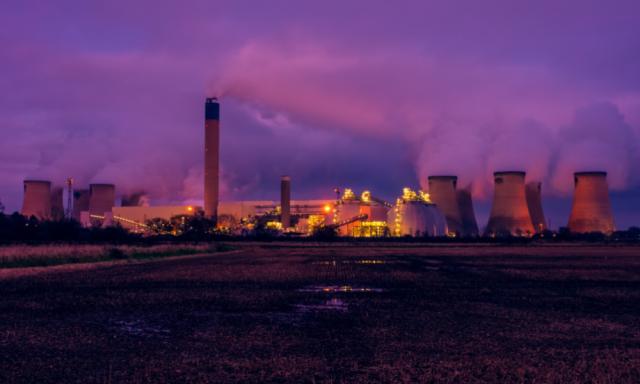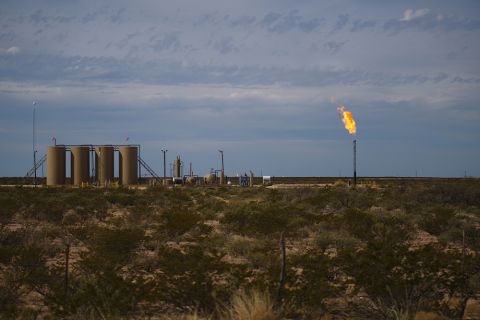
A cold winter's night in January with the bright lights of a U.K. power station reflected in a waterlogged farmer's field. (Source: Coatesy/Shutterstock.com)
The world is gaining ground on the road to net-zero greenhouse gas emissions as the so-called energy transition takes hold. Whether it hits the goal by 2050, however, remains to be seen.
Some sectors and technologies are not on track. Adding to this challenge is increasing energy demand, though consumption is becoming less carbon intense.
“I’m optimistic that we could get, if not, to net zero at least close to net zero with scaling up many of the technologies we have today and with very significant progress on a large number of other technologies, inclusive of some net negative technologies like direct air capture,” Ryan Wiser, senior scientist of Lawrence Berkeley National Laboratory’s electricity markets and policy department, said April 13 during UT Energy Week hosted by The University of Texas at Austin.
The power sector has already cut its CO2 emissions by more than half over a 15-year period, he said. The drop was attributed to lower demand for electricity along with growth in renewables, nuclear energy and natural gas, which saw a 112% jump in usage from 2005 to 2020.
“Wind and solar combined delivered 13 times more electric power than projected in the year 2020,” he said after pointing out electricity demand was 24% less than projected in 2020. “Nuclear continues to churn out 20% of our total generation, and of course, everyone understands natural gas prices and as a consequence, natural gas electricity generation have increased substantially.”
However, getting to the finish line will require a revised roadmap, technology advancement and thoughtful policies, according to Wiser. It will also take being more realistic, better use of existing technologies and working in sync with various stakeholders and players.
Carnegie Mellon University professor Vivian Loftness, who spoke on the panel with Wiser and Exxon Mobil Corp.’s Vijay Swarup, added she’s optimistic of reaching net zero by 2050 but only if “we understand that demand has to go down.”

“We cannot just assume that we’re going to continue to cruise along at the demand rate and much less demand growth and meet it with better, more renewable energy sources,” Loftness said. “I’m afraid that there’s a lot of emphasis on the idea of if we can just come up with all the right sources, business as usual can continue.”

Loftness hit on what she called an important message: using the right type of energy for the right outcome. Use daylight for lighting, for example, instead of electric light.
“We need electricity to run our computers. We don’t need electricity, necessarily, to heat and cool. We can use geothermal energy to heat and cool,” she said.
The world is underutilizing natural energies that “we should be playing to the hilt and maybe learning from the developing world who just didn’t have the energy resources to displace them.” Another example she cited was only cooling the room that is occupied rather than air conditioning the entire building.
Referencing findings in the Accelerating Decarbonization of the U.S. Energy System report by the National Academies of Science, Engineering and Medicine, Loftness said reaching net zero requires electrifying everything, deep energy efficiency and productivity, producing carbon-free electricity, expanding the innovation toolkit and building critical infrastructure.
A big part of the problem is the buildings sector, according to Loftness.
Think of lit-up downtown skylines. She called the buildings sector “the sloppiest sector of energy use” because of its huge amounts of fossil fuel electricity usage.
Besides turning off the lights, there are other ways to improve efficiency and cut emissions.
Cogeneration or polygeneration power systems for simultaneous heating, cooling and electricity production using multiple natural resources can improve efficiency and lower emissions. However, “conservation is always first. It doesn’t make sense to just put a big machine into an inefficient house. You should make an efficient house and then put a small machine.”
Swarup, vice president of R&D for Exxon Mobil, was optimistic about the world’s ability to reach net zero by 2050
“But I’m also a realist. … We can drive it with technology. I think we need to innovate. I think we need to collaborate in ways we haven’t done before,” Swarup said. “This is a decades-long problem. … We have to be pragmatic in the scale and the capital that’s going to be required.”
He pointed out that of the 40 technology areas that the International Energy Agency said is needed to reach net zero, 34 are not on track.
RELATED: Exxon Mobil R&D VP Talks 'Technology Gap' in Energy
“That doesn’t mean progress isn’t being made. It simply means that we are at that fork in the road,” Swarup said. “We are at the point where we need to accelerate technology development.”
Collaboration, he said, is crucial. That is collaboration, not just among industry peers, but collaboration with universities, national labs and smaller companies and larger ones with the resources to unleash technologies at scale.
A key aspect of the energy transition, as moderator and UT-Austin assistant professor Benjamin Leibowicz pointed out, is helping developing nations with projected emissions growth to essentially leapfrog environmental harmful technologies and adopt cleaner ones.
“So much of what we need to do in this space is anticipating and then driving the breakthroughs to close the gaps that we have. That’s exactly what needs to happen,” Swarup said.
If plans call for building a power plant, incorporate carbon capture to avoid a retrofit later; think of hydrogen in the role of electrification in the industrial sector, which needs high temperatures for certain applications.
Another set of technologies will be required, however, to get to net zero, Wiser added.
“Maybe that’s very long duration and storage. Maybe that’s flexible, small modular nuclear reactors,” he said. “Maybe that’s fossil generation with CCS that is run flexibly.”
Besides being used as a fuel for electricity production in fuel cells, hydrogen could be used to fuel turbines in the power sector.
“There is a variety of technologies there; none of them are at scale, but many of them could serve that last remaining 10, 20, 30% part of the picture.”
What is clear is that there is no singular solution, Swarup said, adding a large array of options are needed.
“Those are going to be geographically dependent. They’re going to be dependent on infrastructure and policy as well,” he said. “In research, what we’re focusing on is options. We’re trying to accelerate the speed at which we can take options to scale, and I think that’s one way to close this gap.”
Recommended Reading
Waha NatGas Prices Go Negative
2024-03-14 - An Enterprise Partners executive said conditions make for a strong LNG export market at an industry lunch on March 14.
Williams Beats 2023 Expectations, Touts Natgas Infrastructure Additions
2024-02-14 - Williams to continue developing natural gas infrastructure in 2024 with growth capex expected to top $1.45 billion.
Summit Midstream Launches Double E Pipeline Open Season
2024-04-02 - The Double E pipeline is set to deliver gas to the Waha Hub before the Matterhorn Express pipeline provides sorely needed takeaway capacity, an analyst said.
Kinder Morgan Sees Need for Another Permian NatGas Pipeline
2024-04-18 - Negative prices, tight capacity and upcoming demand are driving natural gas leaders at Kinder Morgan to think about more takeaway capacity.
For Sale? Trans Mountain Pipeline Tentatively on the Market
2024-04-22 - Politics and tariffs may delay ownership transfer of the Trans Mountain Pipeline, which the Canadian government spent CA$34 billion to build.






